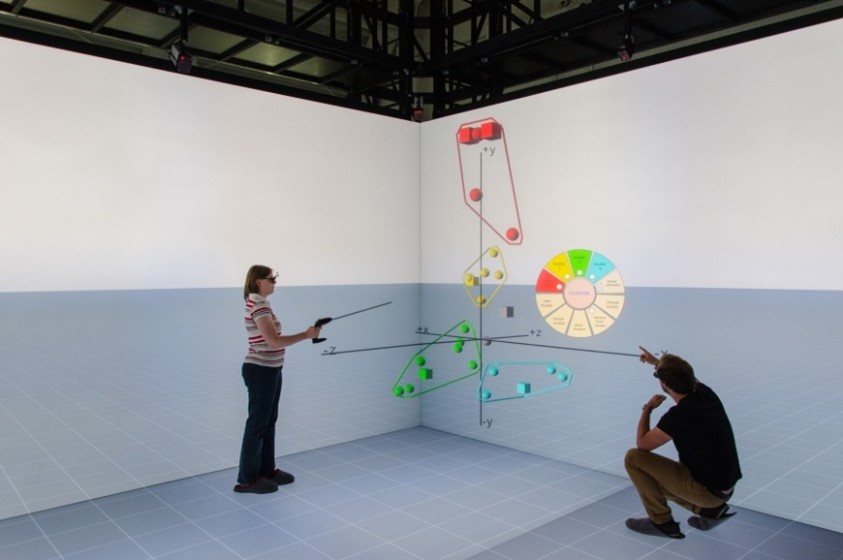James Fenwick, Researcher, CENTRIC.
Deliverable 3.1 of INFINITY produced a research report on immersive reality, collaborative, and analysis methods. Beginning with an exploration into current state the art practices, the report presented guidance for general collaborative data analysis in XR environments, before providing final advice on LEA activity within an XR Environment.
The report begins with examining Computer Supported Cooperation Work (CSCW) which has been used extensively across a multitude of industries and is commonly used within the field of data analysis.
CSCW systems can be shaped to best match the team’s practices and availability. Johansen outlined a matrix providing solutions for geographic distribution and whether individuals were collaborating at the same time or at different times. For example, teams working at the same time and same place might use digital whiteboards and wall displays, where as a team working at the same time in a different place would use video conferencing solutions.
Figure 1 Johansen’s CSCW Matrix [1]
Previous research has explored aspects such as team configuration, group size and task structure, each of which have been identified to influence the quality and quantity of contributions that individuals provide.
With the emergence of XR technologies, new opportunities to visualise and analyse data have begun to take shape in a new field known as Immersive Analytics. Immersive Analytics utilises and extends techniques and practices found in traditional CSCW, whilst removing physical distractions and allowing data to be viewed and controlled in new dimensions.
Since the mid-90s, CAVE systems have been utilised for Immersive Analytics. CAVE systems operate by projecting a display across multiple displays surrounding the user. The cost and space required to operate the environments however were often deemed to be too prohibitive for mass adoption. The past few years has however seen the emergence and popularity of Head Mounted Displays (HMDs) grow substantially. HMDs offer a cost effective and portable solution, allowing greater access to Immersive Analytics practices than ever before.

Figure 2 CAVE based Data analysis in the RWTH aixCAVE [2]
But why use Immersive Analytics over traditional CSCW?
Firstly, Immersive Analytics provides analysts unique opportunities to visualize, structure, and engage with their data in ways which were previous impossible or highly impractical.
Secondly, studies have shown that the immersion and presence, that extended reality can provide, often compliment human traits such as visual perception and spatial memory [3,4,5]. By exploiting these traits extended reality can offer new possibilities to visualize data and work collaboratively with others both locally and remotely.

Figure 3 A HMD based Immersive Analysis Space
The INFINITY project aims to utilise the latest innovations in extended reality and visual analytics to revolutionise data driven investigations within law enforcement. As such, a strong understanding of the state of the art of these fields was deemed critical for the project’s success. Deliverable 3.1 oversaw research into existing XR applications, Computer Supported Cooperation Work and data analysis surrounding the security domain, with the intention of examining current limitations and identifying opportunities for the INFINITY project to explore.
Common data mining techniques were examined including entity extraction, cluster analysis, association rule mining, classification techniques and social network analysis. It was deemed that the understanding of each of these techniques would be an important step for anyone wanting to develop an effective data analysis platform.
D3.1 reviewed several aspects of visualisations used for advanced data analysis. Traditionally these methods take place utilising a 2D display, but by understanding the strengths and weaknesses they provide, can give key insight into how they can be further developed and exploited within an Immersive Environment.
The full Deliverable 3.1 document is expected to be publicly available on the INFINITY Website in November 21.
Sources:
[1] R. Johansen, Groupware: Computer Support for Business Teams, the Free Press, New York (1988).
[2] Image sourced from: https://vr.rwth-aachen.de/page/past_research
[3] Eric Krokos, C. P. (2018, May 16). Virtual memory palaces: immersion aids recall. 23. Virtual Reality. doi:https://doi.org/10.1007/s10055-018-0346-3
[4] Chan, R. (2020, October 12). The Science Of Virtual Reality: How VR Helps With Memory Retention. VR Focus. Retrieved February 22, 2021, from https://www.vrfocus.com/2020/10/the-science-of-virtual-reality-how-vr-helps-with-memory-retention/
[5] Gillies, M. (2018, November 26). Purposeful Practice for learning social skills in VR. Medium. Retrieved February 22, 2021, from https://medium.com/virtual-reality-virtual-people/purposeful-practice-for-learning-social-skills-in-vr-362657cbfc88